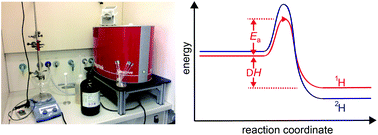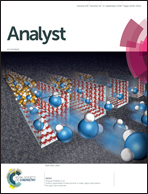Online monitoring of the kinetic isotope effect in chemical reactions with 1H and 19F low-field NMR spectroscopy†
Abstract
The kinetic isotope effect (KIE) describes the change in the rate of a chemical reaction by substituting one of the atoms in the reactants with one of its isotopes. Investigating the KIE and its temperature dependency in reactions renders information for reconstructing chemical processes and confirming the rate-determining step. However, conventional methods to study the KIE, e.g. by calorimetry, conductivity, titration, Raman spectroscopy etc., require calibration and sophisticated handling of the reaction calorimeter, and the data are obtained at irregular and sparse intervals. This current study employs a compact NMR system as an alternative means to determine the temperature dependency of the reaction rate and, thus, the KIE, as well as the activation energy, enthalpy, and entropy of each reaction. Here the neutral hydrolysis of acetic anhydride and ethyl trifluoroacetate was studied in H2O, D2O and H2O–D2O mixtures with 1H and 19F NMR spectroscopy. The activation energies for the hydrolysis of acetic anhydride with D2O and H2O were found to be 45 ± 2 kJ mol−1 and 40 ± 2 kJ mol−1, respectively. The activation energies of ethyl trifluoroacetate hydrolysis via19F NMR spectroscopy were determined to 46.7 ± 1 kJ mol−1 and 54.9 ± 1 kJ mol−1 for the reaction with H2O and D2O, respectively, and via1H NMR spectroscopy to 48 ± 3 kJ mol−1 and 55.8 ± 1 kJ mol−1. The differences in rate constants and activation energies for both reactions in H2O and D2O are due to the kinetic isotope effect, involving the breakage and formation of O–H and O–D bonds during the rate-determining step. The proton inventory studies were performed for both the reactions for determining the isotopic fractionation factors for the given transition states of the reactions which help to predict the reaction mechanisms of other similar reactions. The compact NMR system is a relevant and practical tool to unmask precise reaction pathways, by tracing the KIE in real time with densely sampled data, which are essential for obtaining accurate rate constants.

- This article is part of the themed collection: Analyst Recent HOT articles


 Please wait while we load your content...
Please wait while we load your content...